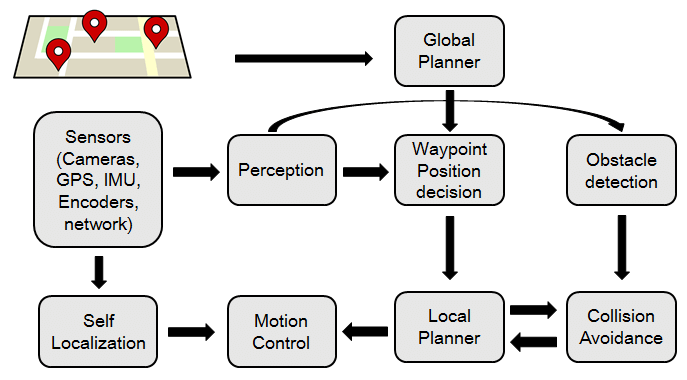What is Autonomous Systems?

Autonomous Systems are systems that can achieve a set of goals in a changing environment without human control or intervention. These systems can sense the environment, keep track of their current state and location, and act in a safe manner to avoid risks to human safety, property, or the system itself.
The top 10 use cases of Autonomous Systems are:
- Autonomous Vehicles: Self-driving cars and trucks that can navigate roads and transport passengers or goods.
- Robotics: Autonomous robots that can perform tasks in various industries such as manufacturing, healthcare, and agriculture.
- Drones: Unmanned aerial vehicles that can be used for surveillance, delivery, mapping, and more.
- Smart Homes: Autonomous systems that control and optimize various aspects of a home, such as lighting, temperature, and security.
- Industrial Automation: Autonomous systems that automate processes in factories and warehouses, improving efficiency and productivity.
- Healthcare: Autonomous systems that assist in surgeries, monitor patients, and provide personalized healthcare.
- Agriculture: Autonomous systems that automate farming tasks like planting, harvesting, and monitoring crops.
- Energy Management: Autonomous systems that optimize energy usage in buildings or power grids.
- Logistics and Supply Chain: Autonomous systems that manage inventory, track shipments, and optimize logistics operations.
- Environmental Monitoring: Autonomous systems that collect data on environmental conditions, such as air quality, water quality, and weather.
What are the feature of Autonomous Systems?

The features of Autonomous Systems include:
- Sensing: Autonomous systems have sensors to gather information about their environment.
- Decision-making: These systems have algorithms and logic to process sensor data and make decisions.
- Planning: Autonomous systems can create plans or strategies to achieve their goals.
- Adaptability: These systems can adapt to changes in the environment or to new situations.
- Safety: Autonomous systems prioritize safety and avoid actions that may pose risks to humans or the system itself.
- Communication: These systems can communicate with other systems or humans to exchange information or coordinate actions.
How Autonomous Systems works and Architecture?

The architecture of Autonomous Systems can vary depending on the specific application and domain. However, there are some common components and principles:
- Perception: This component involves sensors and algorithms to perceive and understand the environment.
- Decision-making: This component processes the sensor data and generates actions or plans based on predefined rules or machine learning algorithms.
- Control: This component executes the actions generated by the decision-making component, controlling the system’s actuators.
- Communication: Autonomous systems may require communication with other systems or humans to exchange information or coordinate actions.
- Integration: Autonomous systems often need to integrate with other systems or devices to achieve their goals.
- Safety and Security: These systems have mechanisms to ensure the safety and security of the system and its interactions with the environment.
How to Install Autonomous Systems?
The installation process for Autonomous Systems can vary depending on the specific system and its requirements. Here are some general steps to install an Autonomous System:
- Determine the system requirements: Understand the hardware, software, and network requirements of the Autonomous System.
- Prepare the environment: Set up the necessary infrastructure, such as servers, sensors, actuators, and network connectivity.
- Install the software: Install the software components of the Autonomous System, including the operating system, middleware, and application software.
- Configure the system: Configure the system settings, parameters, and rules according to the desired behavior and goals.
- Test and validate: Test the system to ensure it is functioning correctly and meets the desired performance and safety criteria.
- Deploy and monitor: Deploy the system in the target environment and continuously monitor its performance, making any necessary adjustments or updates.
It’s important to note that the installation process can vary greatly depending on the specific Autonomous System and its complexity. It’s recommended to refer to the documentation and instructions provided by the system’s manufacturer or developer for detailed installation steps and best practices.
Basic Tutorials of Autonomous Systems: Getting Started
To learn about autonomous systems, you can follow these step-by-step tutorials:

Step-by-Step Basic Tutorial for Building Autonomous Systems:
- Define the Scope and Use Case:
- Clearly define the scope of your autonomous system and the specific use case it will address. Decide on the tasks the system needs to perform autonomously.
- Hardware Selection and Integration:
- Choose suitable hardware components, such as sensors, actuators, and processing units, based on the system’s requirements. Integrate them into the system.
- Data Collection and Perception:
- Implement sensor data acquisition and processing modules to perceive the environment. This may involve cameras, LIDAR, radar, GPS, etc.
- Sensor Fusion and Localization:
- Integrate data from multiple sensors and use algorithms like SLAM (Simultaneous Localization and Mapping) to estimate the system’s position and orientation.
- Path Planning and Decision Making:
- Develop algorithms for path planning and decision-making to determine the system’s actions based on its perception of the environment and predefined objectives.
- Control Systems:
- Implement control systems that translate high-level decisions into low-level commands for actuators to execute the planned actions.
- Safety Measures:
- Incorporate safety mechanisms to handle unexpected situations and ensure the system’s behavior remains within acceptable boundaries.
- Testing and Simulation:
- Test the autonomous system in simulation environments and real-world scenarios to validate its performance and identify potential issues.
- Iterative Development:
- Continuously refine and improve the system based on testing results and user feedback.
- Regulatory Compliance:
- For certain applications, ensure that the autonomous system complies with relevant regulations and standards.
Please note that building an autonomous system is a significant undertaking that often involves interdisciplinary teams with expertise in robotics, machine learning, computer vision, and more. It is essential to keep safety, ethics, and legal considerations in mind throughout the development process.
- Why Can’t I Make Create A New Folder on External Drive on Mac – Solved - April 28, 2024
- Tips on How to Become a DevOps Engineer - April 28, 2024
- Computer Programming Education Requirements – What You Need to Know - April 28, 2024

